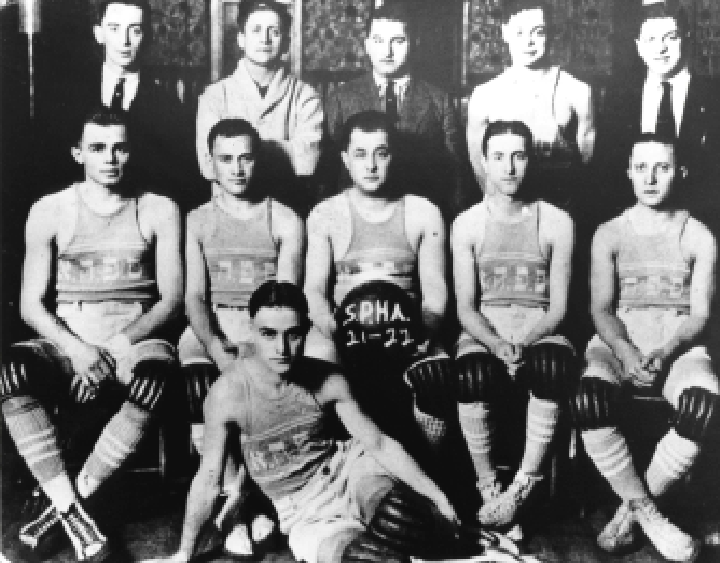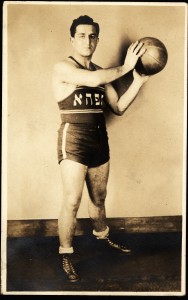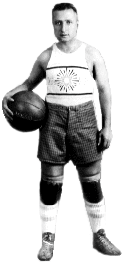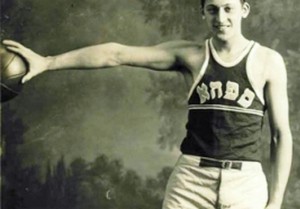
The SPHAS: The Life and Times of Basketball’s Greatest Jewish Team. By Douglas Stark. Temple University Press, 2011.
The Mogul. By Rich Westcott. Temple University Press, 2008.
Jewball. By Neal Pollack. Published as an electronic book by Amazon.com.
The Philadelphia Sphas were America’s outstanding basketball team from the 1920s to the end of World War II. They won more championships in America’s top pro league than any other team.
They were an all-Jewish team that wore Hebrew letters on their uniforms even though it was an era of widespread anti-Semitism. (The name is an acronym for South Philadelphia Hebrew Association.) Owner-coach Eddie Gottlieb and his boys attracted fans by flaunting the idea of a minority group battling “against the world.”
“Half the crowds would come to see us win and the other half would come hoping to see us get killed,” recalled Harry Litwack [pictured here], a Sphas player who was Gottlieb’s closest friend and, later, the long-time basketball coach at Temple University. 
Small wonder that three books have appeared to explore this forgotten chapter in American sports history.
Douglas Stark’s book, The SPHAs, documents the story in more detail than anyone else has done. He includes box scores and seasonal statistics, which Stark accessed through his job at the Basketball Hall of Fame in Springfield, Mass. Stark’s book includes rare photographs of players as he describes how these Jews fought stereotypes of Jewish weakness and inferiority while increasing the popularity of the game.
The Mogul, written in 2008 by the prolific sports historian Rich Westcott, examines the life of Gottlieb, who later owned the Philadelphia Warriors and functioned as the NBA’s de facto chief executive. (In a masterpiece of mixed metaphors, Gotty once remarked that the NBA’s president, Maurice Podoloff, “didn’t know his ass from first base when it came to basketball.”)
Neal Pollack’s novel, Jewball, meanwhile, focuses on a real Sphas player from the late 1930s, Inky Lautman (so-called because he had black hair). Pollack’s book is populated with other real people connected to the Sphas, like the announcer Dave Zinkoff and the singer Kitty Kallen.
Pollack’s fictional Lautman in 1937 saw crypto-Nazis from the anti-Semitic German-American Bund “hunched behind the basket in their khaki shirts…sipping rye from little silver flasks with swastikas on the sides.” This fact-based novel then flies off into a giddy world of fictitious spies and adventure.
All three books, unfortunately, are based largely on second-hand information. Stark researched his after almost all of the original Sphas had died. (He did speak with some of their children.) Consequently, his book contains a few errors and omissions of which I’m aware because my mother went to school with the founders of the Sphas and taught in the Philadelphia school system alongside two of them, and their children became my friends.
Stark identifies Herman (Chickie) Passon as one of the team’s three co-founders, along with Gottlieb and Hughie Black. But Chickie was the kid brother of the actual co-founder, Harry Passon. On the right, Hughie Black:
Stark also erroneously writes that Gottlieb changed his team’s name to the Warriors in 1926 and entered them in a new league. Actually, those Warriors were created by the racketeer Boo Boo Hoff to become Philadelphia’s franchise in a new, big-city American Basketball League, and he hired Gottlieb to coach the team. Simultaneously, Gottlieb continued to own and coach the Sphas, and the two teams were totally separate from each other. Westcott’s book tells the story accurately.
Nor do these books say enough about the wire cages that surrounded basketball courts before 1930. On outdoor playgrounds, a cage was needed to keep loose balls from bouncing into street traffic. Indoor courts were surrounded by chicken wire braced by two-by-four lumber to keep the ball from hitting spectators.
“You shoulda played when we had cages,” Gottlieb once said. “We used to bounce-pass the ball off of the wire, like racquetball. You’d come away from games with cage marks all over your body.”
Thus was born the employment of “cagers” as a word to describe basketball players. It was still used when I wrote sports for my high school newspaper around 1950. It worked for headlines because it was short. (We tried using “dribblers” but that sounded disgusting.)
As for Pollack’s fictitious Jewball, let the record show that the real Inky Lautman was tall for those days, at six foot two— not “the smallest guy on the court” as Pollack describes him. [Lautman photo is below]
Maybe I should assemble the transcripts of my conversations with the players and coaches and write my own book.

Read other reviews on The Cultural Critic